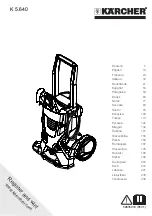
Fig.10
Low Pressure
5. MAINTENANCE
WARNING!
Ensure you read, understand and apply Section 1 safety instructions.
WARNING!
Dry running can seriously damage the unit.
WARNING!
DO NOT leave washer switched on for more than 15 minutes without operating trigger.
Important! The washer motor will stop as soon as the gun trigger is released and will restart when
the trigger is squeezed. Always allow at least 5 seconds between releasing the trigger and restarting.
4.1
Primary checks.
Check that the inlet filter is clean; pump delivery and pressure will be reduced if
blocked. Never use the machine without a filter (which is fitted inside the hose connector, see Fig.1-4).
Ensure that the water supply, high pressure hose and gun are correctly connected, and that air can
freely circulate around the washer.
4.2
Operation of safety catch.
To prevent accidental operation of the unit the safety catch should always
be engaged when the gun is not in use. Swing the catch into position over the end of the trigger as
shown in Fig.7-3. To release the catch press it above the trigger as indicated in Fig.7-1.
4.3
Operating the machine.
Hold the spray gun firmly to counteract the recoil caused by the high pressure
of the water. Before switching on ensure that the lance is not directed at people, objects or animals
prior to being directed at the object to be cleaned. Depress the trigger before switching on the unit
before every use. Switch the machine on by pressing the button marked
‘I’
as shown
in Fig.8. Release the safety catch (see Fig.7-1). Point the lance at the object to be cleaned and
fully depress the trigger. (When the trigger is released the motor will automatically switch off).
4.4
Adjusting spray pattern and pressure.
The spray pattern can be continuously varied from a fine jet to a fan pattern by rotating the
body of the nozzle as indicated in Fig.11. Furthermore the pressure can be switched between high and low by pushing or pulling the
nozzle along the axis of the lance. Shifting the nozzle forwards selects low pressure and shifting the nozzle backwards selects high
pressure as shown in Fig.10.
4.5
Using detergent.
(Variable Nozzle only) Use only detergents approved for use in pressure washers.
For soap application use the low pressure setting on the lance. (If the high pressure setting is selected detergent solution will not be
discharged). Remove the cap from the detergent reservoir situated at the back of the machine and fill it with a suitable cleaning
solution. Select the low pressure setting on the nozzle. The chemical will be automatically mixed with the water and discharged
through the nozzle. The quantity of detergent can be adjusted by the dial on the front of the washer (Fig.9).
4.5.1 Dirt is dissolved by applying detergent to the dry surface.
On vertical surfaces, work from the bottom upwards.
4.5.2 Leave the detergent to act for 1 - 2 minutes, but
DO NOT
allow the surface to dry out.
4.5.3 To wash down select the high pressure setting on the lance.
4.5.4 The Rotablast nozzle (see contents, Item 5) gives a high torque cleaning effect on larger areas (ideal for vehicle washing and
removing grime from patio surfaces). Apply the high pressure jet keeping the end of the nozzle approximately 25cm (10”) from
the surface.
4.6
When washing is completed.
4.6.1 Switch the power supply off by pressing the button marked
‘O’
as indicated in Fig.8.
4.6.2 Turn off the water supply tap.
4.6.3 Activate the trigger to discharge residual pressure until no more water comes out of the nozzle.
4.6.4 Engage the trigger safety catch, unplug the machine from the electrical mains power supply and disconnect from the water supply.
4.6.5 Wipe the machine clean and dry and store in a clean, safe, dry, childproof location.
NOTE:
a)
DO NOT
leave motor switched on for more than 15 minutes without operating trigger.
b) If the water pressure drops (i.e. someone else using the same water supply), the washer will not operate correctly. Immediately
switch off the motor and wait until the pressure is restored.
c) Should the motor stop and fail to restart, the built in thermal cut-out may have tripped. Check to ensure that the washer is
connected correctly to electrical and water supplies (also see Section 6 Troubleshooting). Wait 3 minutes for the cut-out to reset
and re-start the motor. If the motor continues to cut out contact your authorised service agent.
d) If storing the washer for a long period during winter, operate the washer with a non-corrosive, non-toxic anti-freeze before storage.
Store detergents according to instructions on the container label.
4. OPERATION
Fig.8
Fig.9
Fig.11
Fan
Jet
WARNING!
Ensure the pressure washer is switched off and unplugged from the mains electrical power supply and turned off at the
mains water tap before performing any maintenance tasks.
5.1
Check, clean or renew the inlet filter (which is fitted inside the hose connector, see Fig.1-4) after every 50 hours of use.
5.2
Ensure that both nozzles are kept clean and free of debris.
5.3
Check unit, gun, nozzle, hose, connections and cables for damage. Immediately replace or repair with genuine parts.
5.4
Storage.
Do not store the unit in premises subject to freezing conditions. If this cannot be guaranteed then the unit should have a
glycol based antifreeze run through it. Immerse the water supply pipe into a container of antifreeze. Immerse the gun/lance into the
same container (without the nozzle attached). Hold the gun trigger open and start the unit. The antifreeze will be drawn into the unit by
suction. When an even, bubble free flow is obtained switch the unit off.
High Pressure
PC3401.V2 Issue: 2 - 01/06/11























